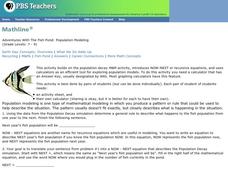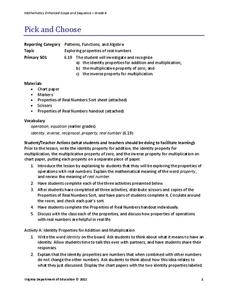Curated OER
Number Sequences
In this number sequences worksheet, students fill in the blanks for the missing numbers in the number sequences containing 2 digit numbers. Students complete 6 number sequences.
Curated OER
Ordering Numbers (Worksheet e)
In this ordering worksheet, students are given a list of four numbers, all containing three digits. Students rewrite the numbers in order, according to the instructions. Some numbers are written greatest to least, and others are...
Curated OER
Seven Sequences and Series Activities
In this sequences and series worksheet, students complete seven activities covering arithmetic sequences, geometric sequences, and series. Fully worked out examples, formulas, and explanations are included.
Curated OER
Skittles Math
In this using Skittles candy to solve problems learning exercise, students count them, sort them by color, make and color a pattern, and line them up to count backwards while eating them to zero. Students complete four activities.
Curated OER
Delightful Designs
In this problem solving worksheet, students complete 4 word problems pertaining to bead necklaces and the patterns used. Students calculate number of beads needed, the cost to buy them and the time necessary to complete the work.
Curated OER
Ordinals
Use beaded necklaces to practice with ordinal numbers and sequencing. For the first, scholars color the beads blue, red, or yellow based on their given positions (1st, 3rd, etc.). The next set of beads has learners do the opposite,...
Curated OER
Dividing Integers
Here is a division worksheet in which learners read about ways to divide integers and then complete problems including patterns, negative and positive numbers, variables, and more. They complete 47 problems total.
Curated OER
Word Problem Solutions
In this word problem solutions learning exercise, learners solve and complete 5 different problems that include solving various types of word problems. First, they calculate the total cost and cost per students for the table shown. Then,...
Curated OER
Bicycles & Tricycles
In this bicycles and tricycles worksheet, learners solve and complete 8 different problems that include counting the number of bicycles and tricycles in each store. First, they complete the table for the number of wheels on the bikes in...
Curated OER
Two-Digit Numbers: 10 More or 10 Less
Complete the sequence by adding or subtracting 10! Although the instructions are slightly vague, the idea is that learners are given a starting number and fill in four sequential numbers by either adding or subtracting 10. The first four...
Curated OER
Countdown Challenge: Multiplication by 10s
In this multiplication by 10s worksheet, 5th graders solve and complete 30 different problems that include multiples of 10. First, they complete the problems in the first section by multiplying each number given times 10. Then, students...
Curated OER
Multiplication Sequences, Multiplying with Exponents
For this math worksheet, students practice making six multiplication sequences. Students write an explanation of four sequences. Students also practice multiplying with exponents by completing twenty problems.
Curated OER
Skip Counting By Hundreds
There are 6 different number sequences for learners to complete. Each contains missing number. They skip count by hundreds to determine which number will best fill in the blank.
Curated OER
Missing Numbers
In this number sequence worksheet, students examine 6 number sequences and fill in 1 missing number in each sequence. Next, students use the strategy of counting by ten to complete 5 different number sequences.
Curated OER
Pattern Worksheet 1
In this pattern worksheet, students continue the patterns pictured below for each row of images. Students also create two new patterns in the blank boxes.
Curated OER
Pascal's Bats
In this number patterns activity, students look for patterns in the bats to help them write the numbers that would be on the 6th row of bats. Students write 2 different patterns they find.
National Security Agency
A Balancing Act: Solving Multi-Step Equations
Wow! Put on that thinking cap and solve multi-step equations. To solve equations, learners review the use of the distributive property and combining like terms. This three-day instructional activity comes with about 20 pages of...
Inside Mathematics
Scatter Diagram
It is positive that how one performs on the first test relates to their performance on the second test. The three-question assessment has class members read and analyze a scatter plot of test scores. They must determine whether...
Virginia Department of Education
Graphing Linear Equations
Combine linear equations and a little creativity to produce a work of art. Math scholars create a design as they graph a list of linear equations. Their project results in a stained glass window pattern that they color.
PBS
Adventures With The Fish Pond: Population Modeling
Build up from the previous activity where your learners charted the population growth and decay of a fish pond with M&Ms®. Have them look at the data from that activity and create a Now-Next, or recursive equations, to predict the...
Virginia Department of Education
Pick and Choose
Properly teach properties with three activities that allow learners to investigate properties of real numbers. The resource covers the identity properties for addition and multiplication, the inverse property for multiplication, and the...
EngageNY
Describing Variability Using the Interquartile Range (IQR)
The 13th instructional activity in a unit of 22 introduces the concept of the interquartile range (IQR). Class members learn to determine the interquartile range, interpret within the context of the data, and finish by finding the IQR...
EngageNY
Mid-Module Assessment Task: Grade 8 Module 6
Make sure pupils have the skills to move on to the second half of the module with a mid-module assessment task. The formative assessment instrument checks student learning before moving on to the rest of the lessons in the unit.
Inside Mathematics
Graphs (2006)
When told to describe a line, do your pupils list its color, length, and which side is high or low? Use a worksheet that engages scholars to properly label line graphs. It then requests two applied reasoning answers.

























